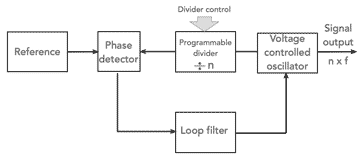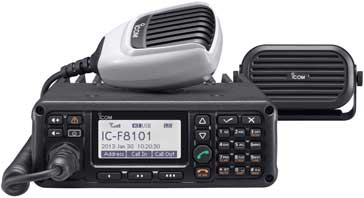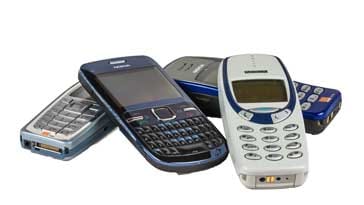What is an RF Frequency Synthesiser: technology & types
RF frequency synthesizer technology is widely used & there are several different types PLL synthesizers, direct and indirect, digital & analogue, etc.
Home » Radio & RF technology » this page
Frequency Synthesizer Tutorials Includes:
Synthesizer basics
PLL / indirect synthesizer
PLL digital synthesizer
PLL analogue synthesizer
Multiloop synthesizer
Fractional N synthesis
Synthesizer phase noise
How to design synthesizer for low phase noise
Direct digital synthesizer, DDS
Frequency synthesizers are used in a host of different RF equipment - almost anywhere that a stable RF source is required.
RF frequency synthesizers provide high levels of performance in terms of stability, programmability and general convenience and performance. As a result the different types of frequency synthesizer are used increasingly in all forms of RF circuit design.As most equipment requiring the use of an RF synthesizer also has digital circuitry for other elements of the device, RF synthesizers lend themselves particularly well to being used - various types have digital circuitry in them and interfacing them to processors and other digital circuitry for ease of control and flexibility.
Accordingly RF frequency synthesizers are used in equipment from simple Bluetooth transmitters and receivers, to Wi-Fi routers and mobile phones right up to very high performance communications systems, satellite links and the like. In fact anything that uses RF communications in almost any form is likely to use an RF synthesizer.

As a result of the performance and capabilities they provide, frequency synthesizers are a common form of RF building block and the RF circuit design is often simplified by the fact that many frequency synthesizer ICs are available with standard RF circuit designs that can be tailored to suit the exact requirement.
RF frequency synthesizer types / categories
There are several different types of categories of synthesizer according to the different techniques and RF circuit design approaches used.
Each of them obviously has its own advantages and disadvantages. There are often choices that can be made about which type to choose according tot he capabilities and performance that is needed.
The broad categories include direct and indirect frequency synthesizers as well as digital and analogue approaches. The overall types and their capabilities and RF design approaches are detailed below.
- Direct: The direct forms of RF frequency synthesizer, are as the name suggests implemented by creating a waveform directly without any form of frequency transforming element. Direct techniques including forms of oscillator and mixer are used.
- Direct Analogue Frequency Synthesis: This form of RF frequency synthesizer was sometimes called a mix-filter-divide architecture. The direct analogue frequency synthesizer gained this name because it accurately defines one of the more popular architectures for this form of synthesis.
The direct analogue frequency synthesizer had several drawbacks: it required a considerable amount of critical circuitry which today does not lend itself to integration; the successive mix processes introduced significant numbers of spurious signals; the spurious signals required considerable levels of filtering, again adding to the cost. As a result, this type of RF synthesizer was only used as a last resort before the widespread availability of RF ICs and the possibility of utilising other forms of frequency synthesis. - Direct Digital Frequency Synthesis: Direct digital synthesizers, DDS are widely used now. They create the signal by having a stored version of the waveform required in digital format, and then advancing the phase in fixed increments. At each increment, the value for the instantaneous voltage of the waveform is looked up in the memory and converted to an analogue format. By advancing the phase and hence taking successive samples, the waveform is built up. The phase advance increments determine the signal frequency that is generated, as this determines how quickly the increments advance along the waveform and hence how quickly the waveform is repeated.
Read more about . . . . direct digital frequency synthesis, DDS.
- Direct Analogue Frequency Synthesis: This form of RF frequency synthesizer was sometimes called a mix-filter-divide architecture. The direct analogue frequency synthesizer gained this name because it accurately defines one of the more popular architectures for this form of synthesis.
- Indirect: Indirect frequency synthesis is based around phase locked loop technology. Here the output signal is generated indirectly. In other words the final signal is generated by an oscillator that is controlled by other signals. In this way the signals used in creating the output are indirectly replicated by the output oscillator, thereby giving the name to this technique.

Frequency sythesizers are used in equipment like this professional transceiver.
Image courtesy Icom UK- Indirect Analogue Frequency Synthesis: Indirect analogue frequency synthesis uses phase locked loop technology with a mixer placed between the voltage controlled oscillator and phase detector. This enables and offset frequency to be introduced into the loop.
Read more about . . . . analogue PLL frequency synthesis.
- Indirect Digital Frequency Synthesis: The indirect digital frequency synthesis techniques introduce a digital divider into the RF phase locked loop between the voltage controlled oscillator and the phase detector. The VCO runs at a frequency equal to the phase comparison frequency times the division ratio. By altering the division ratio, it is possible to alter the frequency of the output signal. Typically the comparison frequency is equal to the channel spacing required. This could be 100 of 50 kHz for an FM tuner, 25 or 12.5 kHz for professional mobile communications systems, etc. It could be much smaller for general radio applications.
Read more about . . . . digital PLL frequency synthesis.
- Indirect Analogue Frequency Synthesis: Indirect analogue frequency synthesis uses phase locked loop technology with a mixer placed between the voltage controlled oscillator and phase detector. This enables and offset frequency to be introduced into the loop.

RF design considerations
When undertaking a new RF design that requires a frequency synthesizer, it is necessary to consider all the capabilities that each type of RF circuit design approach might provide.
When undertaking the initial stages of the design, it is necessary to consider what is required and match this to the optimum approach needed for the synthesizer.
The RF design may involve using a synthesizer that utilises a single approach, or it may involve a more complicated design approach using more than one technique.
When investigating the overall design for an oscillator as part an overall design, it is necessary to consider many different aspects of the design:
Frequency range: One of the main considerations for the RF design will be the frequency range, both in terms of the actual frequency and the range over which the oscillator will be required to operate. If it is only a small range, then an approach using a digital PLL synthesizer on its own may be appropriate However as the range increases a more comprehensive approach may be required, possibly utilising more than one technique.
Step size: Another significant consideration is the step size that is required. If virtually continuous tuning is required, then this may lend itself to one approach rather than another. However if only a relatively limited number of channels are required, then other approaches may be more appropriate. Digital PLL synthesizers are ideal in many ways, but high frequencies combined with small step sizes can result in very very high division ratios which can give rise to other problems. Direct digital synthesizers also have some design balances to be made for small step sizes although they may be more appropriate. Alternatively one type of digital synthesizer may be combined with an analogue PLL synthesiser to act as a frequency translation loop in the overall RF design.
Agility: In some applications it can be necessary for the oscillator to change frequency quickly. This can be a significant consideration that may require a little ingenuity as some types take a while to change from one frequency to another.
Phase noise: Phase noise is a particularly important design consideration these days. Phase noise can significantly affect both data and analogue radio communications systems where it can have degrade the performance by a significant degree if there are significant levels of phase noise. Different RF design approaches using one or more of the different types of synthesizer can be utilised to minimise the level of phase noise on the signal.
These and other aspects need to be considered at the earliest stages of the RF circuit design so that the optimum format for the circuitry can be adopted from the outset. With modern simulation software as well as other calculations it is possible to understand the performance of any approach before it is committed during the design phase.
With RF synthesizers being so widely used within all forms of electronic equipment, their use is very widespread. With many new remote sensors for the Internet of Things using RF links, the use of RF frequency synthesizers of all forms is only going to increase.
Additionally many RF synthesizer chips are available, or frequency synthesizer functionality is included in other application specific chips and this makes the ability to generate accurate and controllable radio frequency signals very easy.
 Written by Ian Poole .
Written by Ian Poole .
Experienced electronics engineer and author.
More Essential Radio Topics:
Radio Signals
Modulation types & techniques
Amplitude modulation
Frequency modulation
OFDM
RF mixing
Phase locked loops
Frequency synthesizers
Passive intermodulation
RF attenuators
RF filters
RF circulator
Radio receiver types
Superhet radio
Receiver selectivity
Receiver sensitivity
Receiver strong signal handling
Receiver dynamic range
Return to Radio topics menu . . .




